Infusion techniques for peripheral arterial thrombolysis
- PMID: 34786692
- PMCID: PMC8595079
- DOI: 10.1002/14651858.CD000985.pub3
Infusion techniques for peripheral arterial thrombolysis
Abstract
Background: Acute limb ischaemia usually is caused by a blood clot blocking an artery or a bypass graft. Severe acute ischaemia will lead to irreversible damage to muscles and nerves if blood flow is not restored in a few hours. Once irreversible damage occurs, amputation will be necessary and the condition can be life-threatening. Infusion of clot-busting drugs (thrombolysis) is a useful tool in the management of acute limb ischaemia. Fibrinolytic drugs are used to disperse blood clots (thrombi) to clear arterial occlusion and restore blood flow. Thrombolysis is less invasive than surgery. A variety of techniques are used to deliver fibrinolytic agents. This is an update of a review first published in 2004.
Objectives: To compare the effects of infusion techniques during peripheral arterial thrombolysis for treatment of patients with acute limb ischaemia.
Search methods: The Cochrane Vascular Information Specialist searched the Cochrane Vascular Specialised Register, CENTRAL, MEDLINE, Embase, and CINAHL databases and World Health Organization International Clinical Trials Registry Platform and ClinicalTrials.gov trials registries to 20 October 2020. We undertook reference checking to identify additional studies.
Selection criteria: We included all randomised controlled trials (RCTs) comparing infusion techniques for fibrinolytic agents in the treatment of acute limb ischaemia.
Data collection and analysis: We used standard methodological procedures as recommended by Cochrane. We assessed the risk of bias in included trials using the Cochrane 'Risk of bias' tool. We evaluated certainty of evidence using GRADE. For dichotomous outcomes, we calculated the odds ratio (OR) with the corresponding 95% confidence interval (CI). We were not able to carry out meta-analyses due to clinical heterogeneity, so we have reported the results and performed the comparisons narratively. The main outcomes of interest were amputation-free survival or limb salvage, amputation, mortality, vessel patency, duration of thrombolysis, and complications such as cerebrovascular accident and major and minor bleeding.
Main results: Nine studies with a total of 671 participants are included in this update. Trials covered a variety of infusion techniques, dosage regimens, and adjunctive agents. We grouped trials according to types of techniques assessed (e.g. intravenous and intra-arterial delivery of the agent, 'high-' and 'low-dose' regimens of the agent, continuous infusion and 'forced infusion' of the agent, use of adjunctive antiplatelet agents). We assessed the certainty of evidence as very low to low due to the limited power of individual studies to deliver clinically relevant results, small and heterogeneous study populations, use of different inclusion criteria by each study in terms of severity and duration of ischaemia, considerably different outcome measures between trials, and use of different fibrinolytic agents. This heterogeneity prevented pooling of data in meta-analyses. No regimen has been shown to confer benefit in terms of amputation-free survival (at 30 days), amputation, or death. For vessel patency, complete success was more likely with intra-arterial (IA) than with intravenous (IV) infusion (odds ratio (OR) 13.22, 95% confidence interval (CI) 2.79 to 62.67; 1 study, 40 participants; low-certainty evidence); radiological failure may be more likely with IV infusion (OR 0.02, 95% CI 0.00 to 0.38; 1 study, 40 participants; low-certainty evidence). Due to the small numbers involved in each arm and design differences between arms, it is not possible to conclude whether any technique offered any advantage over another. None of the treatment strategies clearly affected complications such as cerebrovascular accident or major bleeding requiring surgery or blood transfusion. Minor bleeding complications were more frequent in systemic (intravenous) therapy compared to intra-arterial infusion (OR 0.03, 95% CI 0.00 to 0.56; 1 study, 40 participants), and in high-dose compared to low-dose therapy (OR 0.11, 95% CI 0.01 to 0.96; 1 study, 63 participants). Limited evidence from individual trials appears to indicate that high-dose and forced-infusion regimens reduce the duration of thrombolysis. In one trial, the median duration of infusion was 4 hours (range 0.25 to 46) for the high-dose group and 20 hours (range 2 to 46) for the low-dose group. In a second trial, treatment using pulse spray was continued for a median of 120 minutes (range 40 to 310) compared with low-dose infusion for a median of 25 hours (range 2 to 60). In a third trial, the median duration of therapy was reduced with pulse spray at 195 minutes (range 90 to 1260 minutes) compared to continuous infusion at 1390 minutes (range 300 to 2400 minutes). However, none of the studies individually showed improvement in limb salvage at 30 days nor benefit for the amputation rate related to the technique of drug delivery. Similarly, no studies reported a clear difference in occurrence of cerebrovascular accident or major bleeding. Although 'high-dose' and 'forced-infusion' techniques achieved vessel patency in less time than 'low-dose' infusion, more minor bleeding complications may be associated (OR 0.11, 95% CI 0.01 to 0.96; 1 study, 72 participants; and OR 0.48, 95% CI 0.17 to 1.32; 1 study, 121 participants, respectively). Use of adjunctive platelet glycoprotein IIb/IIIa antagonists did not improve outcomes, and results were limited by inclusion of participants with non-limb-threatening ischaemia.
Authors' conclusions: There is insufficient evidence to show that any thrombolytic regimen provides a benefit over any other in terms of amputation-free survival, amputation, or 30-day mortality. The rate of CVA or major bleeding requiring surgery or blood transfusion did not clearly differ between regimens but may occur more frequently in high dose and IV regimens. This evidence was limited and of very low certainty. Minor bleeding may be more common with high-dose and IV regimens. In this context, thrombolysis may be an acceptable therapy for patients with marginally threatened limbs (Rutherford grade IIa) compared with surgery. Caution is advised for patients who do not have limb-threatening ischaemia (Rutherford grade I) because of risks of major haemorrhage, cerebrovascular accident, and death from thrombolysis.
Copyright © 2021 The Cochrane Collaboration. Published by John Wiley & Sons, Ltd.
Conflict of interest statement
CB: none known. As CB is based within Cochrane Vascular, editorial tasks for this review update were carried out by other members of the Cochrane Vascular editorial team. JP: none known.
Figures
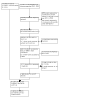

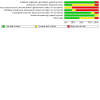
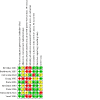
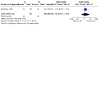
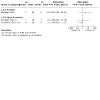
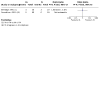
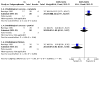
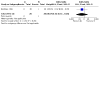
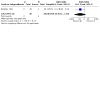

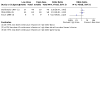
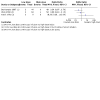
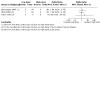
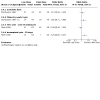
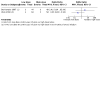
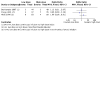
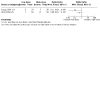
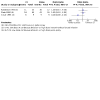
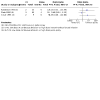



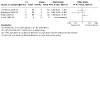
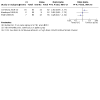
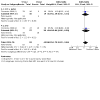
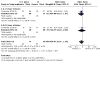
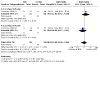
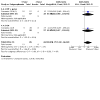



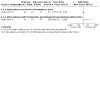
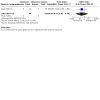

Update of
-
Infusion techniques for peripheral arterial thrombolysis.Cochrane Database Syst Rev. 2004;(1):CD000985. doi: 10.1002/14651858.CD000985.pub2. Cochrane Database Syst Rev. 2004. Update in: Cochrane Database Syst Rev. 2021 Nov 17;11:CD000985. doi: 10.1002/14651858.CD000985.pub3. PMID: 14973961 Updated.
Similar articles
-
Percutaneous thrombectomy or ultrasound-accelerated thrombolysis for initial management of acute limb ischaemia.Cochrane Database Syst Rev. 2022 Jan 4;1(1):CD013486. doi: 10.1002/14651858.CD013486.pub2. Cochrane Database Syst Rev. 2022. PMID: 34981833 Free PMC article.
-
Infusion techniques for peripheral arterial thrombolysis.Cochrane Database Syst Rev. 2004;(1):CD000985. doi: 10.1002/14651858.CD000985.pub2. Cochrane Database Syst Rev. 2004. Update in: Cochrane Database Syst Rev. 2021 Nov 17;11:CD000985. doi: 10.1002/14651858.CD000985.pub3. PMID: 14973961 Updated.
-
Thrombolysis for acute ischaemic stroke.Cochrane Database Syst Rev. 2003;(3):CD000213. doi: 10.1002/14651858.CD000213. Cochrane Database Syst Rev. 2003. Update in: Cochrane Database Syst Rev. 2009 Oct 07;(4):CD000213. doi: 10.1002/14651858.CD000213.pub2. PMID: 12917889 Updated.
-
Lumbar sympathectomy versus prostanoids for critical limb ischaemia due to non-reconstructable peripheral arterial disease.Cochrane Database Syst Rev. 2018 Apr 16;4(4):CD009366. doi: 10.1002/14651858.CD009366.pub2. Cochrane Database Syst Rev. 2018. PMID: 29658630 Free PMC article.
-
Catheter-directed therapies for the treatment of high risk (massive) and intermediate risk (submassive) acute pulmonary embolism.Cochrane Database Syst Rev. 2022 Aug 8;8(8):CD013083. doi: 10.1002/14651858.CD013083.pub2. Cochrane Database Syst Rev. 2022. PMID: 35938605 Free PMC article.
Cited by
-
Endovascular Management of Acute Postprocedural Abdominal Aortic - Iliac Limb Endograft Occlusions: A Case Series.J Cardiovasc Echogr. 2022 Jul-Sep;32(3):187-190. doi: 10.4103/jcecho.jcecho_28_22. Epub 2022 Nov 16. J Cardiovasc Echogr. 2022. PMID: 36619775 Free PMC article. No abstract available.
-
Angiojet pharmacomechanical thrombectomy versus anticoagulant therapy alone in massive cancer-associated thrombosis: a single centre retrospective cohort study.J Thromb Thrombolysis. 2023 Feb;55(2):365-375. doi: 10.1007/s11239-023-02770-5. Epub 2023 Jan 11. J Thromb Thrombolysis. 2023. PMID: 36630028
-
Effects of alteplase and aspirin on functional outcomes in patients with acute ischemic stroke and mild non-disabling neurological deficit.Medicine (Baltimore). 2024 May 31;103(22):e37307. doi: 10.1097/MD.0000000000037307. Medicine (Baltimore). 2024. PMID: 39259128 Free PMC article. Clinical Trial.
References
References to studies included in this review
Berridge 1991 {published data only}
-
- Berridge DC, Gregson RHS, Hopkinson BR, Makin GS. Randomized trial of intra-arterial recombinant tissue plasminogen activator, intravenous recombinant tissue plasminogen activator and intra-arterial streptokinase in peripheral arterial thrombolysis. British Journal of Surgery 1991;78(8):988-95. - PubMed
Braithwaite 1997 {published data only}
-
- Braithwaite BD, Buckenham TM, Galland RB, Heather BP, Earnshaw JJ. Prospective randomized trial of high-dose bolus versus low-dose tissue plasminogen activator infusion in the management of acute limb ischaemia. British Journal of Surgery 1997;84(5):646-50. - PubMed
Comerota 2019 {published data only}
-
- Comerota AJ, Davidovic L, Hannac K, Courtney KL, Shlansky-Goldberg RD. Phase 2, randomized, open-label study on catheter-directed thrombolysis with plasmin versus rtPA and placebo in acute peripheral arterial occlusion. Journal of Drug Assessment 2019;8(1):43-54. [DOI: 10.1080/21556660.2019.1586402] - DOI - PMC - PubMed
-
- EudraCT 2010-019760-36. A phase 2, randomized, open-label (with blinded plasminogen activator and placebo control groups) study to evaluate the effects of different intra-thrombus infusion regimens of plasmin (human) compared to plasminogen activator and placebo in patients with acute lower extremity native artery or bypass graft occlusion. clinicaltrialsregister.eu/ctr-search/trial/2010-019760-36/results (accessed 15 March 2019).
-
- NCT01222117. A study of intra-thrombus plasmin (human) in acute peripheral arterial occlusion. clinicaltrials.gov/ct2/show/NCT01222117 (first received 18 October 2010).
Cragg 1991 {published data only}
-
- Cragg AH, Smith TP, Corson JD, Nakagawa N, Castaneda F, Kresowik TF, et al. Two urokinase dose regimens in native arterial and graft occlusions: initial results of a prospective, randomized clinical trial. Radiology 1991;178(3):681-6. - PubMed
Duda 2001 {published data only}
-
- Duda SH, Tepe G, Luz O, Ouriel K, Dietz K, Hahn U, et al. Peripheral artery occlusion: treatment with abciximab plus urokinase versus with urokinase alone - a randomized pilot trial (the PROMPT study). Platelet receptor antibodies in order to manage peripheral artery thrombosis. Radiology 2001;221(3):689-96. - PubMed
Kandarpa 1993 {published data only}
-
- Kandarpa K, Chopra PS, Aruny JE, Polak JF, Donaldson MC, Whittemore AD, et al. Intra-arterial thrombolysis of lower extremity occlusions: prospective, randomized comparison of forced periodic infusion and conventional slow continuous infusion. Radiology 1993;188(3):861-7. - PubMed
Plate 2006 {published data only}
-
- Plate G, Jansson I, Forssell C, Weber P, Oredsson S. Thrombolysis for acute lower limb ischaemia - a prospective, randomised, multicentre study comparing two strategies. European Journal Vascular and Endovascular Surgery 2006;31:651-60. - PubMed
Saroukhani 2015 {published data only}
-
- Saroukhani A, Ravari H, Rad MP. Effects of intravenous and catheter directed thrombolytic therapy with recombinant tissue plasminogen activator (Alteplase) in non-traumatic acute limb ischemia: a randomized double-blind clinical trial. Bulletin of Emergency and Trauma 2015;3(3):86-92. - PMC - PubMed
Yusuf 1995 {published data only}
-
- Yusuf SW, Whitaker SC, Gregson RHS, Wenham PW, Hopkinson BR, Makin GS. Prospective randomised comparative study of pulse spray and conventional local thrombolysis. European Journal of Vascular and Endovascular Surgery 1995;10(2):136-41. - PubMed
References to studies excluded from this review
Bagan 2013 {published data only}
-
- Bagan P, Dakhil B, Lacal P, Couffinhal JC. Acute peripheral arterial occlusion: prospective study evaluating intra-arterial thrombolysis with a micro-porus balloon catheter. Journal of Endovascular Therapy 2013;20:422-6. - PubMed
Han 2009a {published data only}
-
- Han SM, Weaver FA, Comerota AJ, Perler BA, Joing M. Efficacy and safety of alfimeprase in patients with acute peripheral arterial occlusion (PAO). Journal of Vascular Surgery 2010;51(3):600-9. - PubMed
Han 2009b {published data only}
-
- Han SM, Weaver FA, Comerota AJ, Perler BA, Joing M. Efficacy and safety of alfimeprase in patients with acute peripheral arterial occlusion (PAO). Journal of Vascular Surgery 2010;51(3):600-9. - PubMed
Marder 2012 {published data only}
-
- Marder VJ, Comerota AJ, Shlansky-Goldberg RD, Davis JP, Eng CD, Hanna K, et al. Safety of catheter-delivered plasmin in patients with acute lower extremity arterial or bypass graft occlusion: phase Iresults. Journal of Thrombosis and Haemostasis 2012;10(6):985-91. - PubMed
NCT00073554 {published data only}
-
- NCT00073554. Alfimeprase for thrombolysis in acute peripheral arterial occlusion. clinicaltrials.gov/ct2/show/NCT00073554 (first received 26 November 2003).
NCT00115999 {published data only}
-
- NCT00115999. Study of alfimeprase to rapidly dissolve blood clots in the leg and help prevent the need for surgery on leg arteries. clinicaltrials.gov/ct2/show/NCT00115999 (first received 27 June 2005).
NCT02093468 {published data only}
-
- NCT02093468. Evaluation of MST-188 in acute lower limb ischemia. clinicaltrials.gov/ct2/show/NCT02093468 (first received 21 March 2014).
Poredos 1999 {published data only}
-
- Poredos P, Videcnik V. LYS-plasminogen shortens the duration of a local thrombolytic treatment of peripheral arterial occlusions - a randomized controlled trial. Wiener Klinische Wochenschrift 1999;111(1):21-5. - PubMed
Schweizer 2000 {published data only}
-
- Schweizer J, Kirch W, Koch R, Muller A, Hellner G, Forkmann L. Short- and long-term results of abciximab versus aspirin in conjunction with thrombolysis for patients with peripheral occlusive arterial disease and arterial thrombosis. Angiology 2000;51(11):913-23. - PubMed
Schweizer 2003 {published data only}
-
- Schweizer J, Kirch W, Koch R, Muller A, Hellner G, Forkmann L. Use of abciximab and tirofiban in patients with peripheral arterial occlusive disease and arterial thrombosis. Angiology 2003;54(2):155-61. - PubMed
Verhamme 2012 {published data only}
-
- Verhamme P, Heye S, Peerlinck K, Cahillane G, Tangelder M, Fourneau I, et al. Catheter-directed thrombolysis with microplasmin for acute peripheral arterial occlusion (PAO): an exploratory study. International Angiology 2012;31:289-96. - PubMed
Yuan 2013 {published data only}
-
- Yuan B, Tan L, Zhang Y, Zhang W, Ren T, Yang B. Effects of delivering recombinant tissue plasminogen activator on a new infusion system during endovascular intervention in patients with lower limb ischemia. Thoracic and Cardiovascular Surgeon 2013;61:445-52. - PubMed
Zhang 2014 {published data only}
-
- Zhang Y, Zhang W, Li T, Yuan B, Song S. Efficacy of short-term catheter-directed thrombolysis used with rt-PA combined with endovascular interventional therapy in patients with lower limb ischemia. Zhonghua Yi Xue Za Zhi 2014;94(13):1017-20. [PMID: ] - PubMed
Additional references
Araujo 2019
Berridge 2013
Björck 2020
-
- Björck M, Earnshaw JJ, Acosta S, Gonçalves FB, Cochennec F, Debus ES, et al. European Society for Vascular Surgery (ESVS) 2020 Clinical Practice Guidelines on the Management of Acute Limb Ischaemia. European Journal of Vascular and Endovascular Surgery 2020;59:173-218. - PubMed
Braithwaite 1995
-
- Braithwaite BD, Jones L, Yusuf SW, Dawson K, Berridge DC, Earnshaw JJ. Aspirin improves the outcome of intra-arterial thrombolysis with tissue plasminogen activator. British Journal of Surgery 1995;82:1357-8. - PubMed
Braithwaite 1999
-
- Braithwaite BD, Tomlinson MA, Walker SR, Davies B, Buckenham TM, Earnshaw JJ. Peripheral thrombolysis for acute-onset claudication. British Journal of Surgery 1999;86(6):800-4. - PubMed
Byrne 2014
-
- Byrne RM, Taha AG, Avgerinos E, Marone LK, Makaroun MS, Chaer RA. Contemporary outcomes of endovascular interventions for acute limb ischemia. Journal of Vascular Surgery 2014;59:988-95. - PubMed
Consensus Document
-
- Anonymous. Second European Consensus Document on Chronic Critical Leg Ischemia. Circulation 1991;84(4 Suppl):1-26. - PubMed
Covidence [Computer program]
-
- Covidence. Version accessed 11 November 2019. Melbourne, Australia: Veritas Health Innovation. Available at covidence.org.
Creager 2012
Darwood 2018
Dotter 1974
-
- Dotter CT, Rosch J, Seaman AJ. Selective clot lysis with low dose streptokinase. Radiology 1974;111(1):31-7. - PubMed
Dundar 2003
-
- Dundar Y, Hill R, Dickson R, Whalley T. Comparative efficacy of thrombolytics in acute myocardial infarction: a systematic review. Quarterly Journal of Medicine 2003;96:103-13. - PubMed
Earnshaw 2004
-
- Earnshaw JJ, Whitman B, Foy C. National Audit of Thrombolysis for Acute Leg Ischemia (NATALI): clinical factors associated with early outcome. Journal of Vascular Surgery 2004;39:1018-25. - PubMed
Fontaine 1954
-
- Fontaine VR, Kim M, Kieny R. Surgical treatment for peripheral vascular disease [Die chirurgische Behandlung der peripheren Durchblutungsstorungen]. Helvetica Chirurgica Acta 1954;5/6:499-533. - PubMed
GRADE 2004
Higgins 2011
-
- Higgins JP, Altman DG, Sterne JAC (editors). Chapter 8. Assessing risk of bias in included studies. In: Higgins JP, Green S (editors). Cochrane Handbook for Systematic Reviews of Interventions Version 5.1.0 (updated March 2011). Available from training.cochrane.org/handbook/archive/v5.1/.
Jongkind 2021
-
- Jongkind V, Earnshaw JJ, Gonçalves FB, Cochennec F, Debus ES, Hinchliffe R, et al. Update of the European Society for Vascular Surgery (ESVS) 2020 Clinical Practice Guidelines on the Management of Acute Limb Ischaemia in light of the COVID-19 pandemic, based on a scoping review of the literature. European Journal of Vascular and Endovascular Surgery 2021;(epublished ahead of print):j.ejvs.2021.08.028. [DOI: 10.1016/j.ejvs.2021.08.028] - DOI - PMC - PubMed
Kandarpa 1988
-
- Kandarpa K, Drinker PA, Singer SJ, Caramore D. Forced pulsatile local infusion of enzyme accelerates thrombolysis: in vivo evaluation of a new delivery system. Radiology 1988;168:739-44. - PubMed
Lefebvre 2011
-
- Lefebvre C, Manheimer E, Glanville J. Chapter 6. Searching for studies. In: Higgins JP, Green S editor(s). Cochrane Handbook for Systematic Reviews of Interventions Version 5.1.0 (updated March 2011). The Cochrane Collaboration. Available from training.cochrane.org/handbook/archive/v5.1/.
McNamara 1984
-
- McNamara TO, Fischer JR. Thrombolysis of peripheral arterial and graft occlusions: improved results using high-dose urokinase. American Journal of Roentgenology 1985;144(4):769-75. - PubMed
Norgren 2007
-
- Norgren L, Hiatt WR, Dormandy JA, Nehler MR, Harris KA, Fowkes FGR. Inter-Society Consensus for the Management of Peripheral Arterial Disease (TASC II). Journal of Vascular Surgery 2007;45(1 Suppl S):S5A-66A. - PubMed
Plate 2009
-
- Plate G, Oredsson A, Janke J. When is thrombolysis for acute lower limb ischemia worthwhile? European Journal of Vascular and Endovascular Surgery 2009;37(2):206-12. - PubMed
Review Manager 2020 [Computer program]
-
- Review Manager 5 (RevMan 5). Version 5.4. The Cochrane Collaboration, 2020.
Robertson 2013
Rodgers 2007
-
- Rogers JH, Laird JR. Overview of new technologies for lower extremity revascularization. Circulation 2007;116(18):2072-85. - PubMed
Rutherford 1986
-
- Rutherford RB, Flanigan DP, Gupta SK, Johnston KW, Karmody A, Whittemore AD, et al. Suggested standards for reports dealing with lower extremity ischaemia. Journal of Vascular Surgery 1986;4(1):80-94. - PubMed
SIR standards
-
- Patel N, Sacks D, Patel RI, Moresco KP, Ouriel K, Gray R, et al. SIR reporting standards for the treatment of acute limb ischemia with use of transluminal removal of arterial thrombus. Journal of Vascular and Interventional Radiology 2003;14:S453–S465. - PubMed
STILE 1994
Sullivan 1989
-
- Sullivan KL, Gardiner GA, Shapiro MJ, Bonn J, Levin DC. Acceleration of thrombolysis with a high-dose transthrombus bolus technique. Radiology 1989;173(3):805-8. - PubMed
References to other published versions of this review
Berridge 1997
Publication types
MeSH terms
Substances
Grants and funding
LinkOut - more resources
Full Text Sources

